Exploring Lean Management Principles and Lead Time Optimization
VerifiedAdded on 2023/06/10
|9
|2672
|135
Essay
AI Summary
This essay provides a comprehensive analysis of lean management principles and their application in organizations, with a specific focus on lead time optimization. It delves into core concepts such as process waste, Kaizen, and Kanban, illustrating how these methodologies can enhance productivity, efficiency, and value delivery. The essay also examines the operations management practices of TESCO, highlighting the company's approach to process waste elimination and suggesting further improvements. A practical lead time calculation example is included, demonstrating the impact of sourcing products from different locations. Desklib provides access to similar solved assignments and past papers for students.
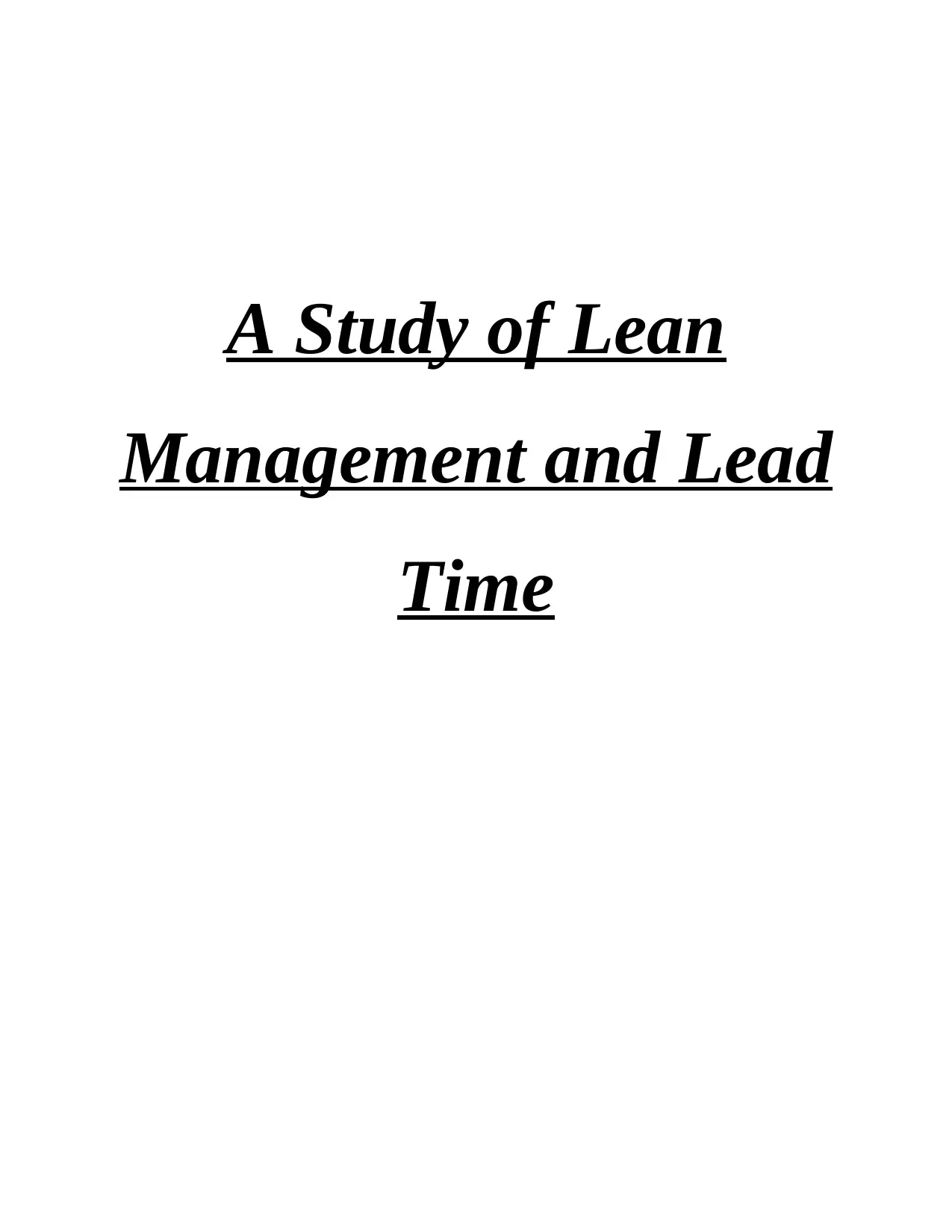
A Study of Lean
Management and Lead
Time
Management and Lead
Time
Paraphrase This Document
Need a fresh take? Get an instant paraphrase of this document with our AI Paraphraser
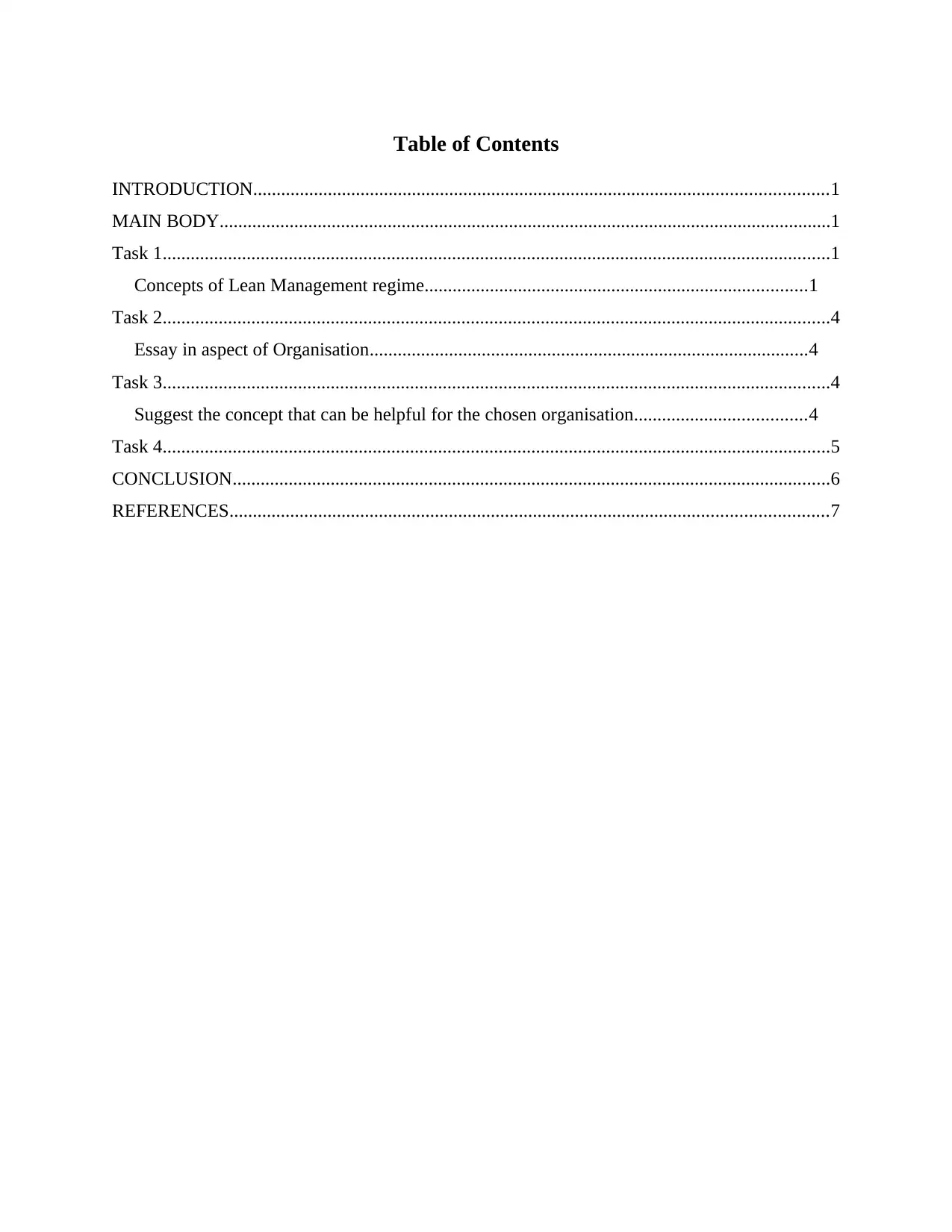
Table of Contents
INTRODUCTION...........................................................................................................................1
MAIN BODY...................................................................................................................................1
Task 1...............................................................................................................................................1
Concepts of Lean Management regime..................................................................................1
Task 2...............................................................................................................................................4
Essay in aspect of Organisation..............................................................................................4
Task 3...............................................................................................................................................4
Suggest the concept that can be helpful for the chosen organisation.....................................4
Task 4...............................................................................................................................................5
CONCLUSION................................................................................................................................6
REFERENCES................................................................................................................................7
INTRODUCTION...........................................................................................................................1
MAIN BODY...................................................................................................................................1
Task 1...............................................................................................................................................1
Concepts of Lean Management regime..................................................................................1
Task 2...............................................................................................................................................4
Essay in aspect of Organisation..............................................................................................4
Task 3...............................................................................................................................................4
Suggest the concept that can be helpful for the chosen organisation.....................................4
Task 4...............................................................................................................................................5
CONCLUSION................................................................................................................................6
REFERENCES................................................................................................................................7
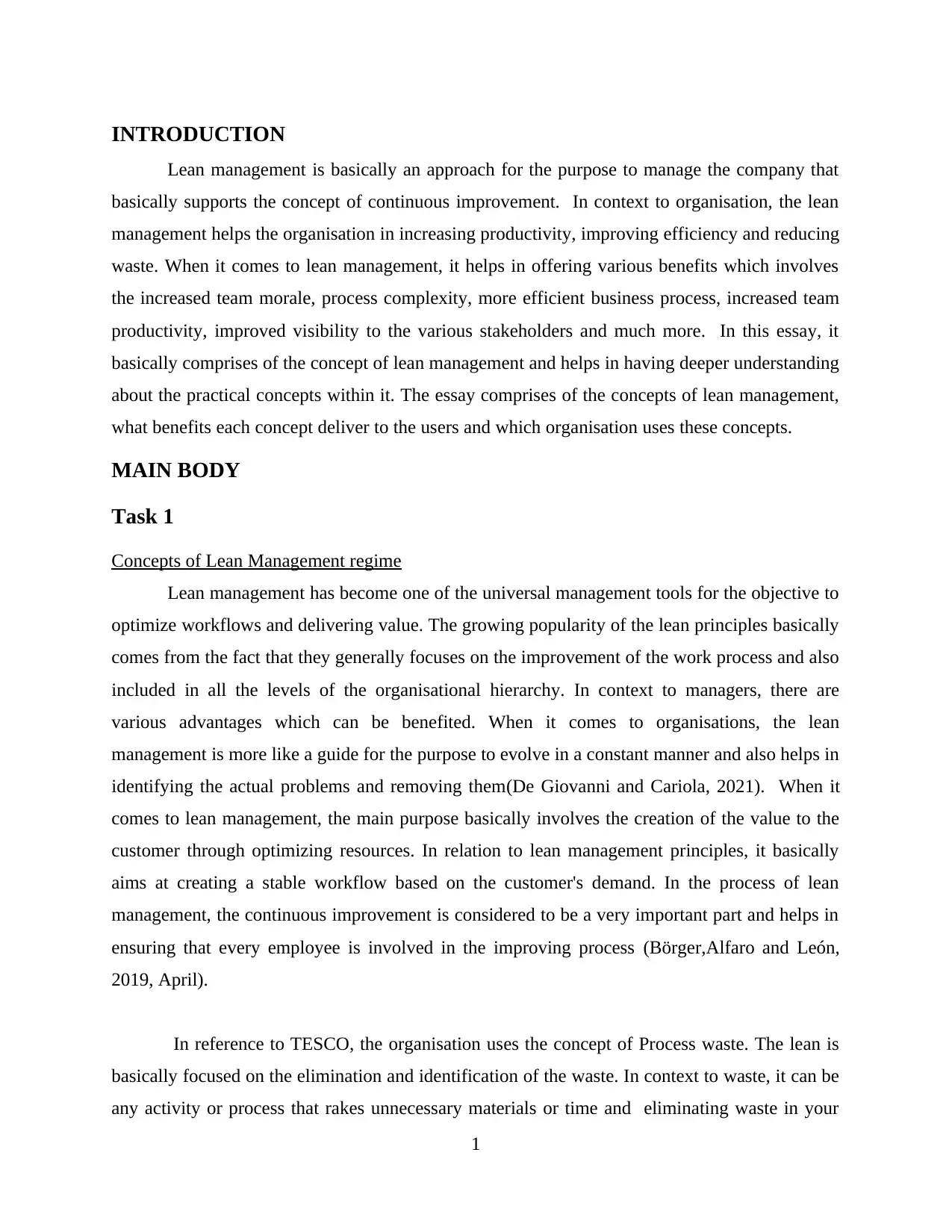
INTRODUCTION
Lean management is basically an approach for the purpose to manage the company that
basically supports the concept of continuous improvement. In context to organisation, the lean
management helps the organisation in increasing productivity, improving efficiency and reducing
waste. When it comes to lean management, it helps in offering various benefits which involves
the increased team morale, process complexity, more efficient business process, increased team
productivity, improved visibility to the various stakeholders and much more. In this essay, it
basically comprises of the concept of lean management and helps in having deeper understanding
about the practical concepts within it. The essay comprises of the concepts of lean management,
what benefits each concept deliver to the users and which organisation uses these concepts.
MAIN BODY
Task 1
Concepts of Lean Management regime
Lean management has become one of the universal management tools for the objective to
optimize workflows and delivering value. The growing popularity of the lean principles basically
comes from the fact that they generally focuses on the improvement of the work process and also
included in all the levels of the organisational hierarchy. In context to managers, there are
various advantages which can be benefited. When it comes to organisations, the lean
management is more like a guide for the purpose to evolve in a constant manner and also helps in
identifying the actual problems and removing them(De Giovanni and Cariola, 2021). When it
comes to lean management, the main purpose basically involves the creation of the value to the
customer through optimizing resources. In relation to lean management principles, it basically
aims at creating a stable workflow based on the customer's demand. In the process of lean
management, the continuous improvement is considered to be a very important part and helps in
ensuring that every employee is involved in the improving process (Börger,Alfaro and León,
2019, April).
In reference to TESCO, the organisation uses the concept of Process waste. The lean is
basically focused on the elimination and identification of the waste. In context to waste, it can be
any activity or process that rakes unnecessary materials or time and eliminating waste in your
1
Lean management is basically an approach for the purpose to manage the company that
basically supports the concept of continuous improvement. In context to organisation, the lean
management helps the organisation in increasing productivity, improving efficiency and reducing
waste. When it comes to lean management, it helps in offering various benefits which involves
the increased team morale, process complexity, more efficient business process, increased team
productivity, improved visibility to the various stakeholders and much more. In this essay, it
basically comprises of the concept of lean management and helps in having deeper understanding
about the practical concepts within it. The essay comprises of the concepts of lean management,
what benefits each concept deliver to the users and which organisation uses these concepts.
MAIN BODY
Task 1
Concepts of Lean Management regime
Lean management has become one of the universal management tools for the objective to
optimize workflows and delivering value. The growing popularity of the lean principles basically
comes from the fact that they generally focuses on the improvement of the work process and also
included in all the levels of the organisational hierarchy. In context to managers, there are
various advantages which can be benefited. When it comes to organisations, the lean
management is more like a guide for the purpose to evolve in a constant manner and also helps in
identifying the actual problems and removing them(De Giovanni and Cariola, 2021). When it
comes to lean management, the main purpose basically involves the creation of the value to the
customer through optimizing resources. In relation to lean management principles, it basically
aims at creating a stable workflow based on the customer's demand. In the process of lean
management, the continuous improvement is considered to be a very important part and helps in
ensuring that every employee is involved in the improving process (Börger,Alfaro and León,
2019, April).
In reference to TESCO, the organisation uses the concept of Process waste. The lean is
basically focused on the elimination and identification of the waste. In context to waste, it can be
any activity or process that rakes unnecessary materials or time and eliminating waste in your
1
⊘ This is a preview!⊘
Do you want full access?
Subscribe today to unlock all pages.

Trusted by 1+ million students worldwide

own tasks can result in making you more productive. In reference to organisation, the company
focuses on eliminating different type of waste which arises from various factors such as over
production, waiting, transportation, unnecessary processing, unnecessary motion, defects and
much more. Another lean management concept is Kaizen. In reference to Kaizen, it is basically
the principle of the continuous improvement (Farrugia, 2018). When it comes to organisation,
taking time to reflect on your productivity and work with the intention of continually getting
better over time results in maximizing the productivity and own efficiency and also helps in
revising your processes to get better. In context to Kaizen, in order to achieve Kaizen is with the
help of problem solving that comprises of various elements such as Planning. It is basically the
identification of the area that generally needs improvements and also helps in stating a
measurable goal for the improvement. Another element is to implement your plan and checking
or reviewing the results against the benchmarks and determining whether the plan was effective
and acting according to that, if the plan was ineffective, repeating the process and revising the
plan.
In context to organisations, the application of the principles and tools of the lean to your
own process and own work and treating the employer as a consumer and adding value for them is
considered to be difficult when looked at from a particular perspective. From another
perspective, the adopting process that creates clarity, build stronger relationships, Improves the
quality of the work, taking less time and much more. When it comes to lean methods, it does not
necessarily need to be applied to the whole companies and they can applied to your whole life
and personal work. In addition to that, there is a strong likelihood that adopting these behaviour
and concepts will be infectious. When it comes to organisations, the lean is to shorten the
product development cycle and rapidly discovering the business concept is viable. When it
comes to the concept of lean management, it was not created in a moment and it was basically
evolved gradually (Shrafat and Ismail 2018).
Kanban was mainly designed to improve the efficiency and effectiveness of processes by
visualising the tasks in the work flow and make it more effective and efficient in many ways.
Kanban is very effective within an organisation because it helps to eliminate the wasteful
activities in the process and improve the overall performance of the management through
2
focuses on eliminating different type of waste which arises from various factors such as over
production, waiting, transportation, unnecessary processing, unnecessary motion, defects and
much more. Another lean management concept is Kaizen. In reference to Kaizen, it is basically
the principle of the continuous improvement (Farrugia, 2018). When it comes to organisation,
taking time to reflect on your productivity and work with the intention of continually getting
better over time results in maximizing the productivity and own efficiency and also helps in
revising your processes to get better. In context to Kaizen, in order to achieve Kaizen is with the
help of problem solving that comprises of various elements such as Planning. It is basically the
identification of the area that generally needs improvements and also helps in stating a
measurable goal for the improvement. Another element is to implement your plan and checking
or reviewing the results against the benchmarks and determining whether the plan was effective
and acting according to that, if the plan was ineffective, repeating the process and revising the
plan.
In context to organisations, the application of the principles and tools of the lean to your
own process and own work and treating the employer as a consumer and adding value for them is
considered to be difficult when looked at from a particular perspective. From another
perspective, the adopting process that creates clarity, build stronger relationships, Improves the
quality of the work, taking less time and much more. When it comes to lean methods, it does not
necessarily need to be applied to the whole companies and they can applied to your whole life
and personal work. In addition to that, there is a strong likelihood that adopting these behaviour
and concepts will be infectious. When it comes to organisations, the lean is to shorten the
product development cycle and rapidly discovering the business concept is viable. When it
comes to the concept of lean management, it was not created in a moment and it was basically
evolved gradually (Shrafat and Ismail 2018).
Kanban was mainly designed to improve the efficiency and effectiveness of processes by
visualising the tasks in the work flow and make it more effective and efficient in many ways.
Kanban is very effective within an organisation because it helps to eliminate the wasteful
activities in the process and improve the overall performance of the management through
2
Paraphrase This Document
Need a fresh take? Get an instant paraphrase of this document with our AI Paraphraser
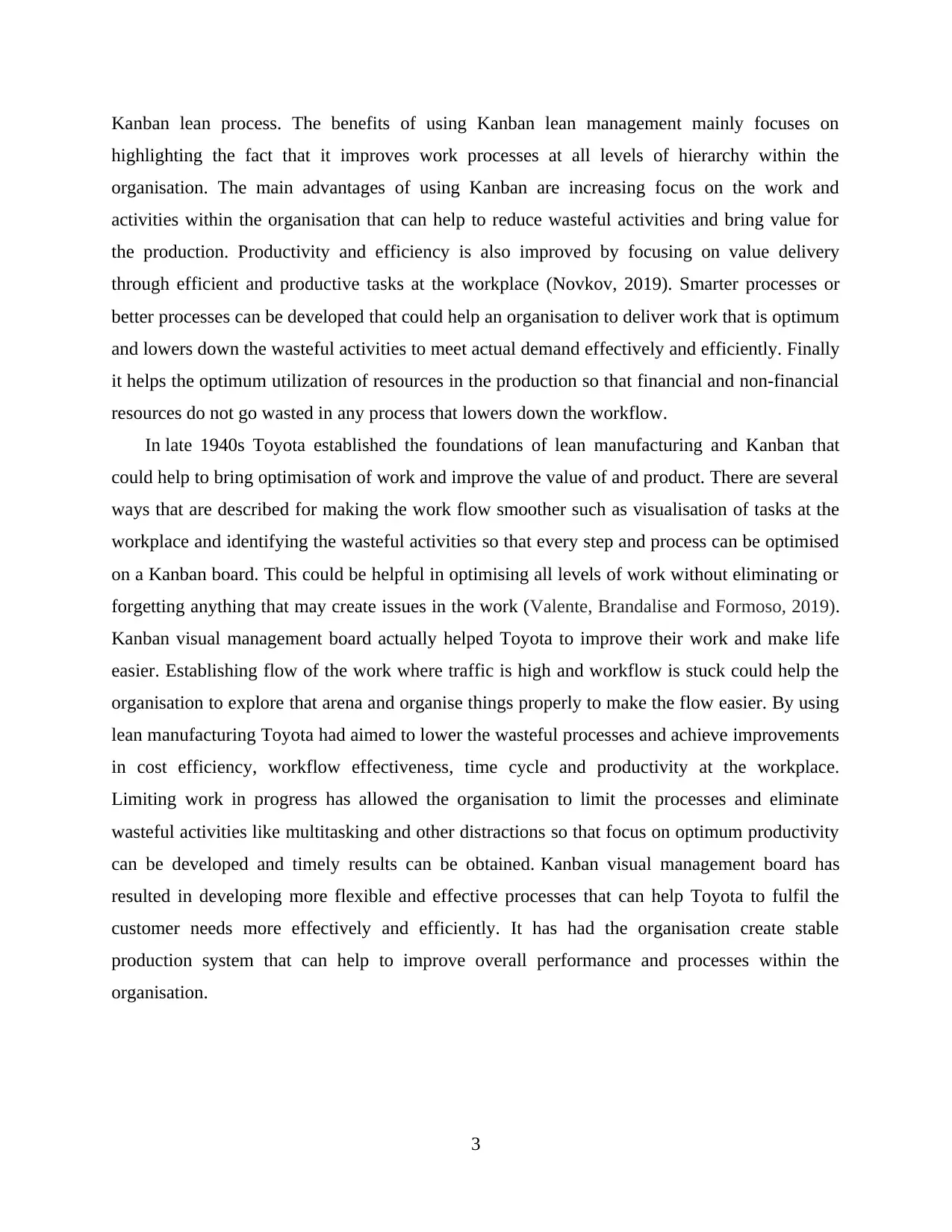
Kanban lean process. The benefits of using Kanban lean management mainly focuses on
highlighting the fact that it improves work processes at all levels of hierarchy within the
organisation. The main advantages of using Kanban are increasing focus on the work and
activities within the organisation that can help to reduce wasteful activities and bring value for
the production. Productivity and efficiency is also improved by focusing on value delivery
through efficient and productive tasks at the workplace (Novkov, 2019). Smarter processes or
better processes can be developed that could help an organisation to deliver work that is optimum
and lowers down the wasteful activities to meet actual demand effectively and efficiently. Finally
it helps the optimum utilization of resources in the production so that financial and non-financial
resources do not go wasted in any process that lowers down the workflow.
In late 1940s Toyota established the foundations of lean manufacturing and Kanban that
could help to bring optimisation of work and improve the value of and product. There are several
ways that are described for making the work flow smoother such as visualisation of tasks at the
workplace and identifying the wasteful activities so that every step and process can be optimised
on a Kanban board. This could be helpful in optimising all levels of work without eliminating or
forgetting anything that may create issues in the work (Valente, Brandalise and Formoso, 2019).
Kanban visual management board actually helped Toyota to improve their work and make life
easier. Establishing flow of the work where traffic is high and workflow is stuck could help the
organisation to explore that arena and organise things properly to make the flow easier. By using
lean manufacturing Toyota had aimed to lower the wasteful processes and achieve improvements
in cost efficiency, workflow effectiveness, time cycle and productivity at the workplace.
Limiting work in progress has allowed the organisation to limit the processes and eliminate
wasteful activities like multitasking and other distractions so that focus on optimum productivity
can be developed and timely results can be obtained. Kanban visual management board has
resulted in developing more flexible and effective processes that can help Toyota to fulfil the
customer needs more effectively and efficiently. It has had the organisation create stable
production system that can help to improve overall performance and processes within the
organisation.
3
highlighting the fact that it improves work processes at all levels of hierarchy within the
organisation. The main advantages of using Kanban are increasing focus on the work and
activities within the organisation that can help to reduce wasteful activities and bring value for
the production. Productivity and efficiency is also improved by focusing on value delivery
through efficient and productive tasks at the workplace (Novkov, 2019). Smarter processes or
better processes can be developed that could help an organisation to deliver work that is optimum
and lowers down the wasteful activities to meet actual demand effectively and efficiently. Finally
it helps the optimum utilization of resources in the production so that financial and non-financial
resources do not go wasted in any process that lowers down the workflow.
In late 1940s Toyota established the foundations of lean manufacturing and Kanban that
could help to bring optimisation of work and improve the value of and product. There are several
ways that are described for making the work flow smoother such as visualisation of tasks at the
workplace and identifying the wasteful activities so that every step and process can be optimised
on a Kanban board. This could be helpful in optimising all levels of work without eliminating or
forgetting anything that may create issues in the work (Valente, Brandalise and Formoso, 2019).
Kanban visual management board actually helped Toyota to improve their work and make life
easier. Establishing flow of the work where traffic is high and workflow is stuck could help the
organisation to explore that arena and organise things properly to make the flow easier. By using
lean manufacturing Toyota had aimed to lower the wasteful processes and achieve improvements
in cost efficiency, workflow effectiveness, time cycle and productivity at the workplace.
Limiting work in progress has allowed the organisation to limit the processes and eliminate
wasteful activities like multitasking and other distractions so that focus on optimum productivity
can be developed and timely results can be obtained. Kanban visual management board has
resulted in developing more flexible and effective processes that can help Toyota to fulfil the
customer needs more effectively and efficiently. It has had the organisation create stable
production system that can help to improve overall performance and processes within the
organisation.
3
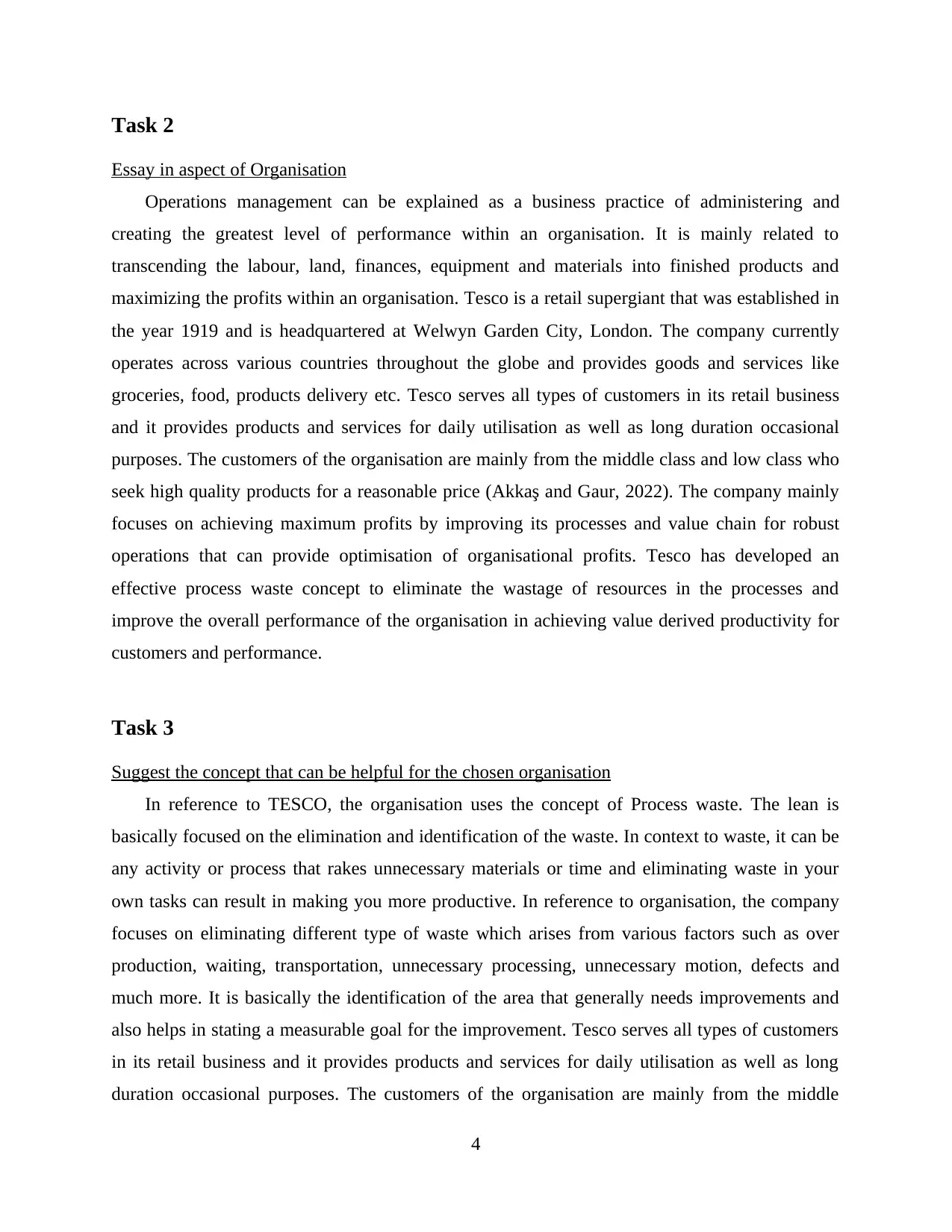
Task 2
Essay in aspect of Organisation
Operations management can be explained as a business practice of administering and
creating the greatest level of performance within an organisation. It is mainly related to
transcending the labour, land, finances, equipment and materials into finished products and
maximizing the profits within an organisation. Tesco is a retail supergiant that was established in
the year 1919 and is headquartered at Welwyn Garden City, London. The company currently
operates across various countries throughout the globe and provides goods and services like
groceries, food, products delivery etc. Tesco serves all types of customers in its retail business
and it provides products and services for daily utilisation as well as long duration occasional
purposes. The customers of the organisation are mainly from the middle class and low class who
seek high quality products for a reasonable price (Akkaş and Gaur, 2022). The company mainly
focuses on achieving maximum profits by improving its processes and value chain for robust
operations that can provide optimisation of organisational profits. Tesco has developed an
effective process waste concept to eliminate the wastage of resources in the processes and
improve the overall performance of the organisation in achieving value derived productivity for
customers and performance.
Task 3
Suggest the concept that can be helpful for the chosen organisation
In reference to TESCO, the organisation uses the concept of Process waste. The lean is
basically focused on the elimination and identification of the waste. In context to waste, it can be
any activity or process that rakes unnecessary materials or time and eliminating waste in your
own tasks can result in making you more productive. In reference to organisation, the company
focuses on eliminating different type of waste which arises from various factors such as over
production, waiting, transportation, unnecessary processing, unnecessary motion, defects and
much more. It is basically the identification of the area that generally needs improvements and
also helps in stating a measurable goal for the improvement. Tesco serves all types of customers
in its retail business and it provides products and services for daily utilisation as well as long
duration occasional purposes. The customers of the organisation are mainly from the middle
4
Essay in aspect of Organisation
Operations management can be explained as a business practice of administering and
creating the greatest level of performance within an organisation. It is mainly related to
transcending the labour, land, finances, equipment and materials into finished products and
maximizing the profits within an organisation. Tesco is a retail supergiant that was established in
the year 1919 and is headquartered at Welwyn Garden City, London. The company currently
operates across various countries throughout the globe and provides goods and services like
groceries, food, products delivery etc. Tesco serves all types of customers in its retail business
and it provides products and services for daily utilisation as well as long duration occasional
purposes. The customers of the organisation are mainly from the middle class and low class who
seek high quality products for a reasonable price (Akkaş and Gaur, 2022). The company mainly
focuses on achieving maximum profits by improving its processes and value chain for robust
operations that can provide optimisation of organisational profits. Tesco has developed an
effective process waste concept to eliminate the wastage of resources in the processes and
improve the overall performance of the organisation in achieving value derived productivity for
customers and performance.
Task 3
Suggest the concept that can be helpful for the chosen organisation
In reference to TESCO, the organisation uses the concept of Process waste. The lean is
basically focused on the elimination and identification of the waste. In context to waste, it can be
any activity or process that rakes unnecessary materials or time and eliminating waste in your
own tasks can result in making you more productive. In reference to organisation, the company
focuses on eliminating different type of waste which arises from various factors such as over
production, waiting, transportation, unnecessary processing, unnecessary motion, defects and
much more. It is basically the identification of the area that generally needs improvements and
also helps in stating a measurable goal for the improvement. Tesco serves all types of customers
in its retail business and it provides products and services for daily utilisation as well as long
duration occasional purposes. The customers of the organisation are mainly from the middle
4
⊘ This is a preview!⊘
Do you want full access?
Subscribe today to unlock all pages.

Trusted by 1+ million students worldwide
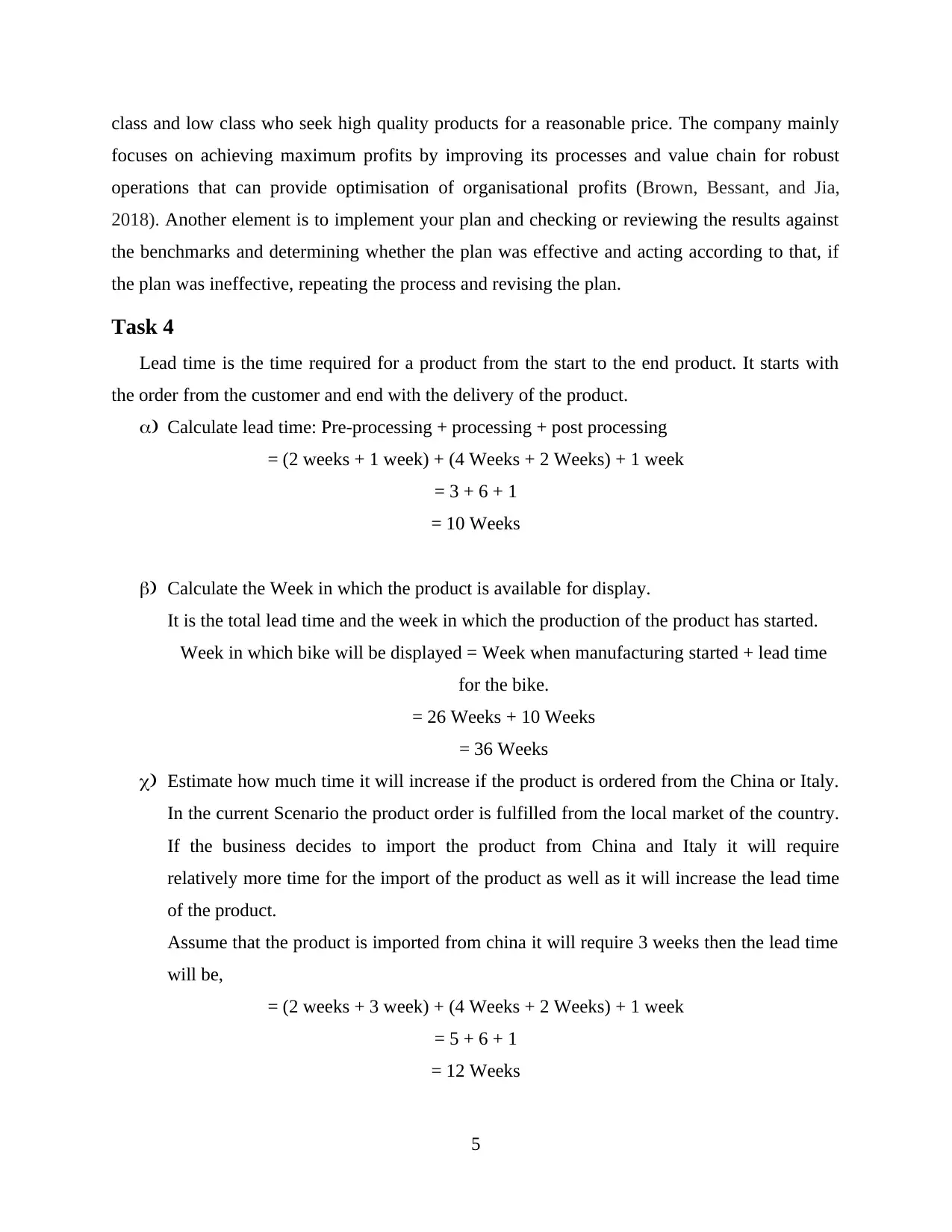
class and low class who seek high quality products for a reasonable price. The company mainly
focuses on achieving maximum profits by improving its processes and value chain for robust
operations that can provide optimisation of organisational profits (Brown, Bessant, and Jia,
2018). Another element is to implement your plan and checking or reviewing the results against
the benchmarks and determining whether the plan was effective and acting according to that, if
the plan was ineffective, repeating the process and revising the plan.
Task 4
Lead time is the time required for a product from the start to the end product. It starts with
the order from the customer and end with the delivery of the product.
a) Calculate lead time: Pre-processing + processing + post processing
= (2 weeks + 1 week) + (4 Weeks + 2 Weeks) + 1 week
= 3 + 6 + 1
= 10 Weeks
b) Calculate the Week in which the product is available for display.
It is the total lead time and the week in which the production of the product has started.
Week in which bike will be displayed = Week when manufacturing started + lead time
for the bike.
= 26 Weeks + 10 Weeks
= 36 Weeks
c) Estimate how much time it will increase if the product is ordered from the China or Italy.
In the current Scenario the product order is fulfilled from the local market of the country.
If the business decides to import the product from China and Italy it will require
relatively more time for the import of the product as well as it will increase the lead time
of the product.
Assume that the product is imported from china it will require 3 weeks then the lead time
will be,
= (2 weeks + 3 week) + (4 Weeks + 2 Weeks) + 1 week
= 5 + 6 + 1
= 12 Weeks
5
focuses on achieving maximum profits by improving its processes and value chain for robust
operations that can provide optimisation of organisational profits (Brown, Bessant, and Jia,
2018). Another element is to implement your plan and checking or reviewing the results against
the benchmarks and determining whether the plan was effective and acting according to that, if
the plan was ineffective, repeating the process and revising the plan.
Task 4
Lead time is the time required for a product from the start to the end product. It starts with
the order from the customer and end with the delivery of the product.
a) Calculate lead time: Pre-processing + processing + post processing
= (2 weeks + 1 week) + (4 Weeks + 2 Weeks) + 1 week
= 3 + 6 + 1
= 10 Weeks
b) Calculate the Week in which the product is available for display.
It is the total lead time and the week in which the production of the product has started.
Week in which bike will be displayed = Week when manufacturing started + lead time
for the bike.
= 26 Weeks + 10 Weeks
= 36 Weeks
c) Estimate how much time it will increase if the product is ordered from the China or Italy.
In the current Scenario the product order is fulfilled from the local market of the country.
If the business decides to import the product from China and Italy it will require
relatively more time for the import of the product as well as it will increase the lead time
of the product.
Assume that the product is imported from china it will require 3 weeks then the lead time
will be,
= (2 weeks + 3 week) + (4 Weeks + 2 Weeks) + 1 week
= 5 + 6 + 1
= 12 Weeks
5
Paraphrase This Document
Need a fresh take? Get an instant paraphrase of this document with our AI Paraphraser
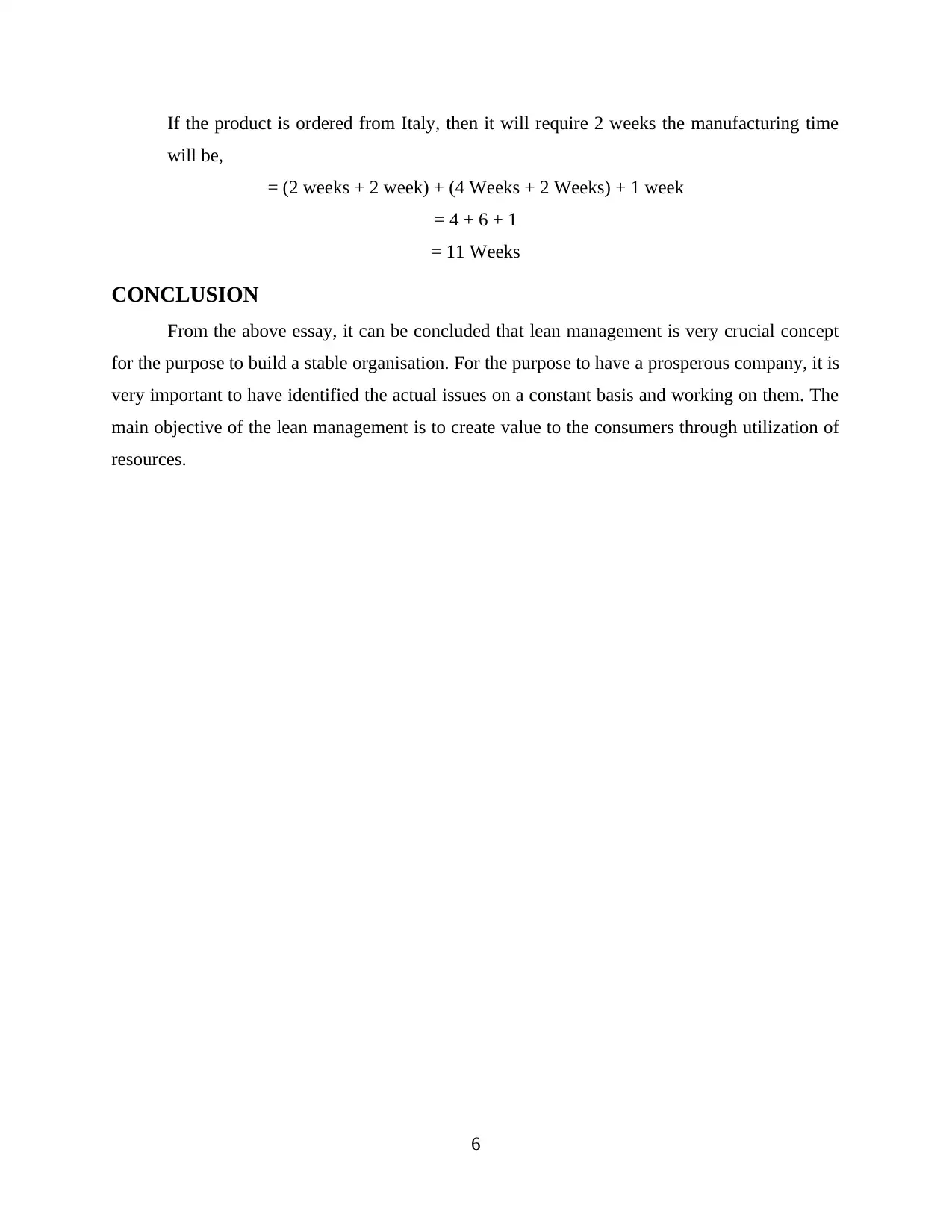
If the product is ordered from Italy, then it will require 2 weeks the manufacturing time
will be,
= (2 weeks + 2 week) + (4 Weeks + 2 Weeks) + 1 week
= 4 + 6 + 1
= 11 Weeks
CONCLUSION
From the above essay, it can be concluded that lean management is very crucial concept
for the purpose to build a stable organisation. For the purpose to have a prosperous company, it is
very important to have identified the actual issues on a constant basis and working on them. The
main objective of the lean management is to create value to the consumers through utilization of
resources.
6
will be,
= (2 weeks + 2 week) + (4 Weeks + 2 Weeks) + 1 week
= 4 + 6 + 1
= 11 Weeks
CONCLUSION
From the above essay, it can be concluded that lean management is very crucial concept
for the purpose to build a stable organisation. For the purpose to have a prosperous company, it is
very important to have identified the actual issues on a constant basis and working on them. The
main objective of the lean management is to create value to the consumers through utilization of
resources.
6
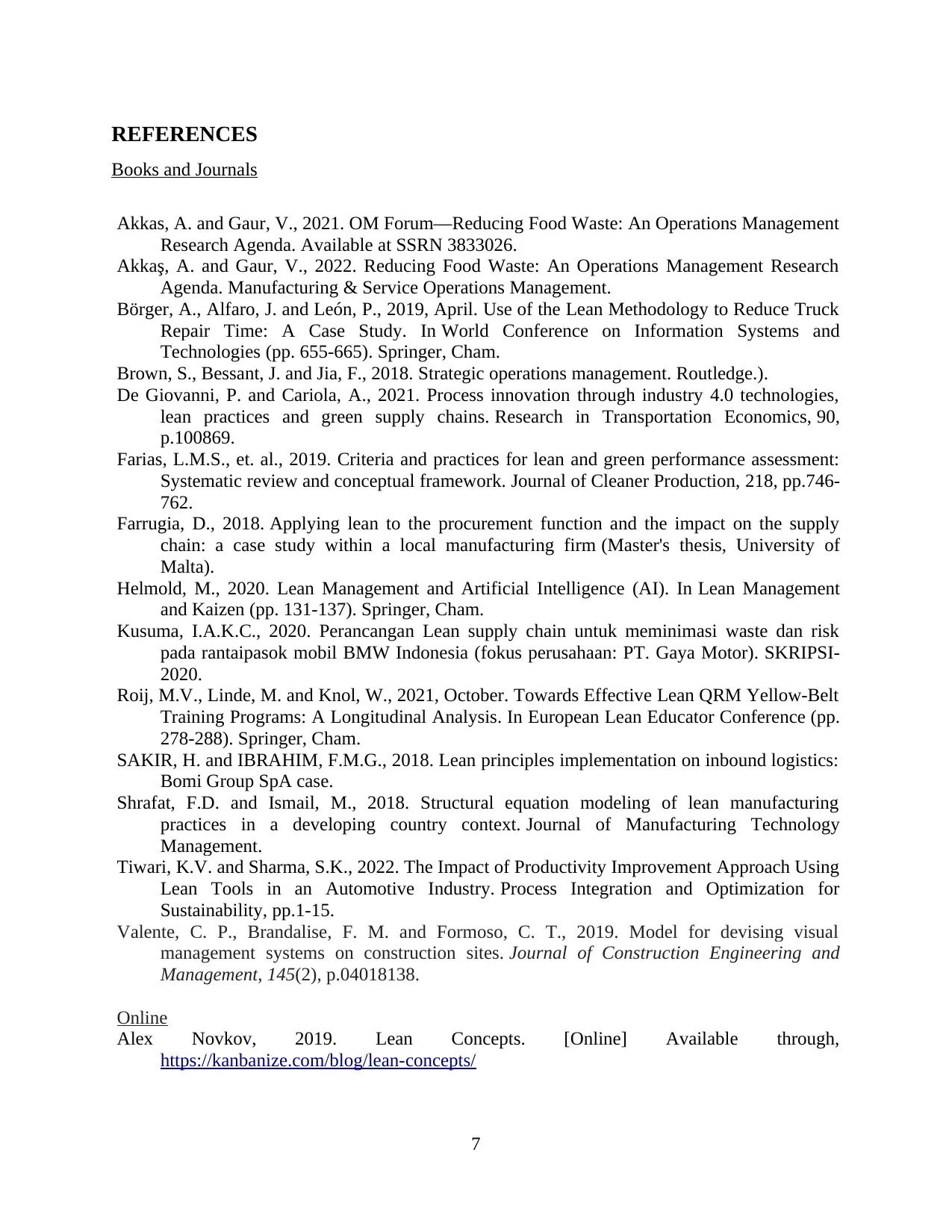
REFERENCES
Books and Journals
Akkas, A. and Gaur, V., 2021. OM Forum—Reducing Food Waste: An Operations Management
Research Agenda. Available at SSRN 3833026.
Akkaş, A. and Gaur, V., 2022. Reducing Food Waste: An Operations Management Research
Agenda. Manufacturing & Service Operations Management.
Börger, A., Alfaro, J. and León, P., 2019, April. Use of the Lean Methodology to Reduce Truck
Repair Time: A Case Study. In World Conference on Information Systems and
Technologies (pp. 655-665). Springer, Cham.
Brown, S., Bessant, J. and Jia, F., 2018. Strategic operations management. Routledge.).
De Giovanni, P. and Cariola, A., 2021. Process innovation through industry 4.0 technologies,
lean practices and green supply chains. Research in Transportation Economics, 90,
p.100869.
Farias, L.M.S., et. al., 2019. Criteria and practices for lean and green performance assessment:
Systematic review and conceptual framework. Journal of Cleaner Production, 218, pp.746-
762.
Farrugia, D., 2018. Applying lean to the procurement function and the impact on the supply
chain: a case study within a local manufacturing firm (Master's thesis, University of
Malta).
Helmold, M., 2020. Lean Management and Artificial Intelligence (AI). In Lean Management
and Kaizen (pp. 131-137). Springer, Cham.
Kusuma, I.A.K.C., 2020. Perancangan Lean supply chain untuk meminimasi waste dan risk
pada rantaipasok mobil BMW Indonesia (fokus perusahaan: PT. Gaya Motor). SKRIPSI-
2020.
Roij, M.V., Linde, M. and Knol, W., 2021, October. Towards Effective Lean QRM Yellow-Belt
Training Programs: A Longitudinal Analysis. In European Lean Educator Conference (pp.
278-288). Springer, Cham.
SAKIR, H. and IBRAHIM, F.M.G., 2018. Lean principles implementation on inbound logistics:
Bomi Group SpA case.
Shrafat, F.D. and Ismail, M., 2018. Structural equation modeling of lean manufacturing
practices in a developing country context. Journal of Manufacturing Technology
Management.
Tiwari, K.V. and Sharma, S.K., 2022. The Impact of Productivity Improvement Approach Using
Lean Tools in an Automotive Industry. Process Integration and Optimization for
Sustainability, pp.1-15.
Valente, C. P., Brandalise, F. M. and Formoso, C. T., 2019. Model for devising visual
management systems on construction sites. Journal of Construction Engineering and
Management, 145(2), p.04018138.
Online
Alex Novkov, 2019. Lean Concepts. [Online] Available through,
https://kanbanize.com/blog/lean-concepts/
7
Books and Journals
Akkas, A. and Gaur, V., 2021. OM Forum—Reducing Food Waste: An Operations Management
Research Agenda. Available at SSRN 3833026.
Akkaş, A. and Gaur, V., 2022. Reducing Food Waste: An Operations Management Research
Agenda. Manufacturing & Service Operations Management.
Börger, A., Alfaro, J. and León, P., 2019, April. Use of the Lean Methodology to Reduce Truck
Repair Time: A Case Study. In World Conference on Information Systems and
Technologies (pp. 655-665). Springer, Cham.
Brown, S., Bessant, J. and Jia, F., 2018. Strategic operations management. Routledge.).
De Giovanni, P. and Cariola, A., 2021. Process innovation through industry 4.0 technologies,
lean practices and green supply chains. Research in Transportation Economics, 90,
p.100869.
Farias, L.M.S., et. al., 2019. Criteria and practices for lean and green performance assessment:
Systematic review and conceptual framework. Journal of Cleaner Production, 218, pp.746-
762.
Farrugia, D., 2018. Applying lean to the procurement function and the impact on the supply
chain: a case study within a local manufacturing firm (Master's thesis, University of
Malta).
Helmold, M., 2020. Lean Management and Artificial Intelligence (AI). In Lean Management
and Kaizen (pp. 131-137). Springer, Cham.
Kusuma, I.A.K.C., 2020. Perancangan Lean supply chain untuk meminimasi waste dan risk
pada rantaipasok mobil BMW Indonesia (fokus perusahaan: PT. Gaya Motor). SKRIPSI-
2020.
Roij, M.V., Linde, M. and Knol, W., 2021, October. Towards Effective Lean QRM Yellow-Belt
Training Programs: A Longitudinal Analysis. In European Lean Educator Conference (pp.
278-288). Springer, Cham.
SAKIR, H. and IBRAHIM, F.M.G., 2018. Lean principles implementation on inbound logistics:
Bomi Group SpA case.
Shrafat, F.D. and Ismail, M., 2018. Structural equation modeling of lean manufacturing
practices in a developing country context. Journal of Manufacturing Technology
Management.
Tiwari, K.V. and Sharma, S.K., 2022. The Impact of Productivity Improvement Approach Using
Lean Tools in an Automotive Industry. Process Integration and Optimization for
Sustainability, pp.1-15.
Valente, C. P., Brandalise, F. M. and Formoso, C. T., 2019. Model for devising visual
management systems on construction sites. Journal of Construction Engineering and
Management, 145(2), p.04018138.
Online
Alex Novkov, 2019. Lean Concepts. [Online] Available through,
https://kanbanize.com/blog/lean-concepts/
7
⊘ This is a preview!⊘
Do you want full access?
Subscribe today to unlock all pages.

Trusted by 1+ million students worldwide
1 out of 9
Related Documents
Your All-in-One AI-Powered Toolkit for Academic Success.
+13062052269
info@desklib.com
Available 24*7 on WhatsApp / Email
![[object Object]](/_next/static/media/star-bottom.7253800d.svg)
Unlock your academic potential
Copyright © 2020–2025 A2Z Services. All Rights Reserved. Developed and managed by ZUCOL.





